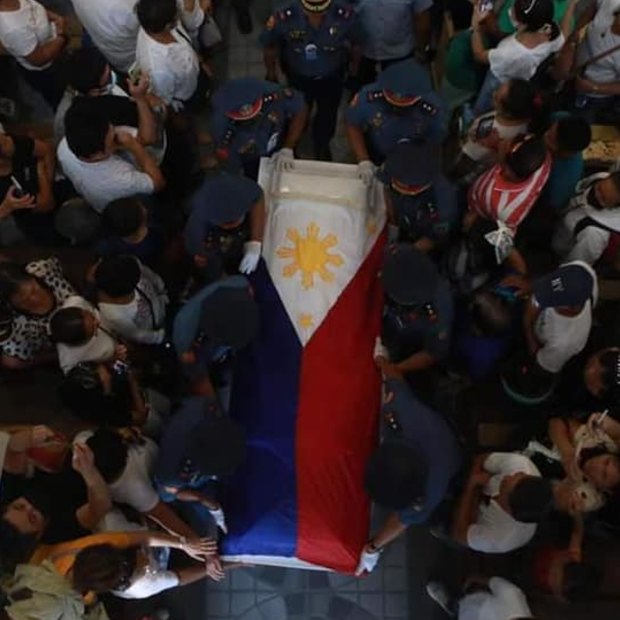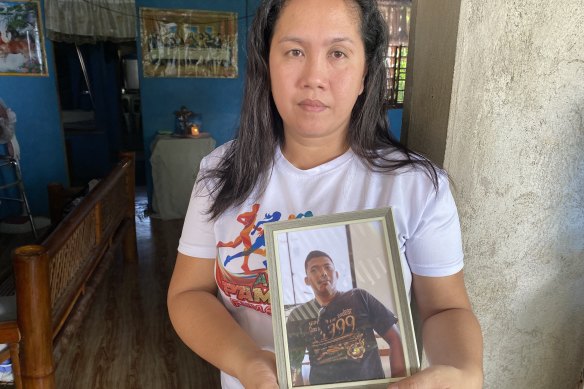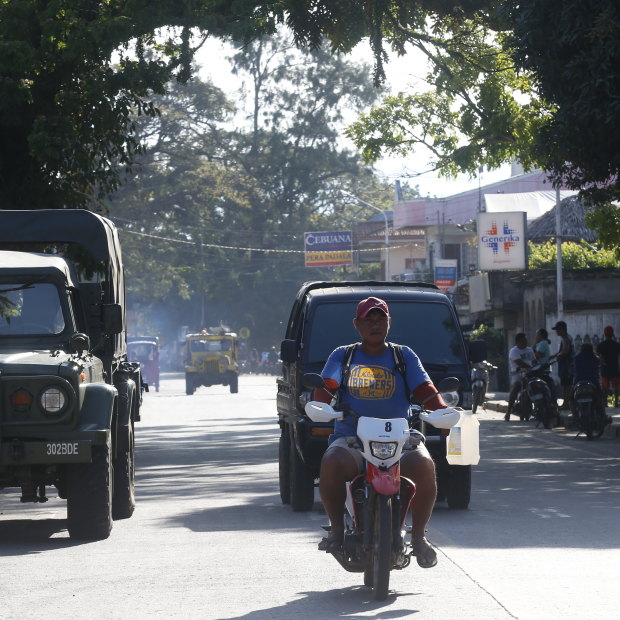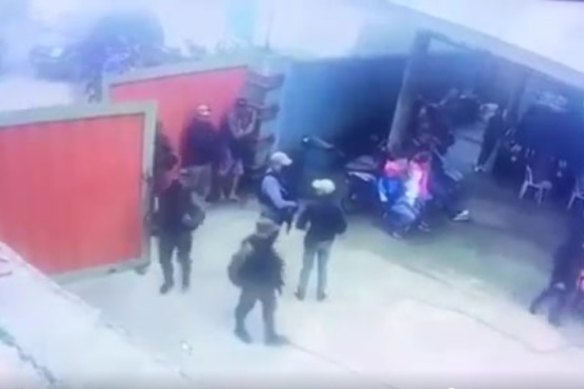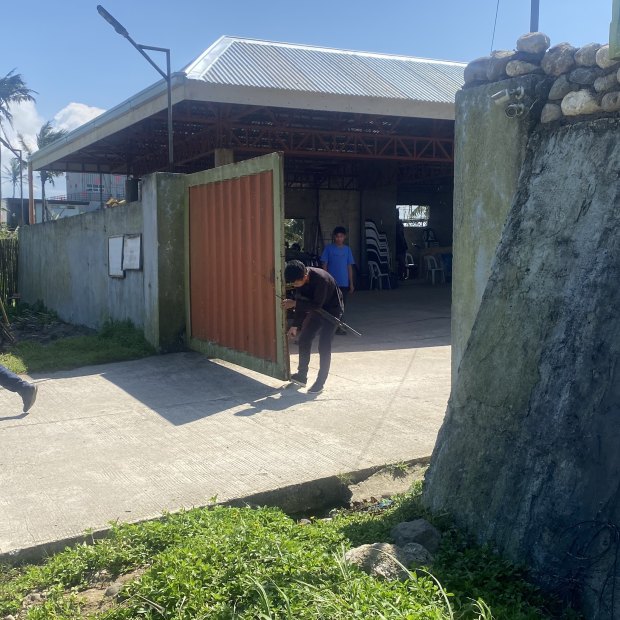By Chris Barrett
Dumaguete, Philippines: It began with a knock on the front gate. After pulling up in a convoy of four-wheel drives, six men casually approached the entrance to Roel Degamo’s compound, in the hills above the town of Pamplona, and asked to come in and see him.
Inside, in a makeshift reception area usually used as a car park, the 56-year-old governor of Negros Oriental province was meeting with locals, as he did most Saturday mornings.
Negros Oriental Governor Roel Degamo, seated with his family, was shot and killed in his own residential compound in Pamplona, Philippines.Credit:Facebook/govdegamo
This face-to-face outing with residents, however, was about to take a most sinister turn.
Allowed through the gate despite wielding assault rifles, the men, clad in military garb and bulletproof vests, strode in and spent a few seconds surveying the scene.
Then they opened fire. Degamo, seated behind a desk as he spoke with people, was gunned down, as were eight others before the assassins retreated to their vehicles and raced off.
The brazen daylight slaying has rocked even the Philippines, one of the most dangerous places in the world to be a publicly elected official.
Amid the vengeful and violent regional and local politics so entrenched in south-east Asia’s second most populous nation, there have been mayors and vice-mayors murdered with frequency over the years, not to mention politicians’ relatives and others such as journalists.
Degamo, though, was the country’s first sitting governor to be assassinated in 35 years.
Thousands of people gathered in Degamo’s hometown of Siaton for his funeral last week.Credit:Facebook
Almost three weeks later, authorities are rounding up the perpetrators, who are mostly ex-soldiers, but questions remain unanswered on the streets of Negros Oriental and across the archipelago.
Why were the gunmen let in? Why were personnel from Degamo’s security detail not on duty that day? Who was the mastermind? And when will the killing with impunity stop?
‘When I got to him he was already dying’
Mary Ann Ramirez was sitting just metres from Degamo when the shooting broke out on March 4. The chair of her village council, the 43-year-old mother was accompanying a woman seeking cash assistance from the governor to pay for medical expenses.
Her husband, 41-year-old Jose Marie Salma Ramirez, also a village councillor, was also among the crowd of about 300 in the compound.
Mary Ann Ramirez, whose husband Josie Marie was shot and killed in the attack on Degamo’s compound.Credit:Chris Barrett
Here in the Central Visayas, one of the poorest regions of the Philippines, it was customary for the governor to dig into his own deep pockets, as it is in other areas of a country where clientelism thrives.
Mary Ann and the woman had grabbed a ticket number and were waiting in the queue to speak to Degamo, who she knew well.
She then heard someone yell “drop” before the hail of bullets was unleashed. She took cover as best she could.
“After the gunman left and the gate was closed, I ran to the governor. I saw that he was already gone,” she said, speaking to The Sydney Morning Herald and The Age in her nearby village of Yupisan.
“Then I ran towards one of the security guards at the gate. He asked me to help him because he thought he was dying. Then after that I proceeded to my husband.”
He had also been shot.
“When I got to him he was already dying. He was lying near the gate. I told him ‘I’m alive, I’m alive’,” she said. “He nodded his head, then he passed away.”
Mary Ann believes her husband, one of the nine killed in the incident, was hit because he had been standing near the gate and was mistaken by the hitmen for a member of Degamo’s security crew.
Not that the reason matters much now. The couple had recently adopted a two-month-old girl and with her two other children, aged 21 and 22, studying in Manila, she is contemplating how to tend to their small farm alone.
“I’m still dreaming if it happened or not,” she said. “How do I begin from scratch? My children are away in college. Who will take care of the farm?
“We want peace to reign here in Negros Oriental because a lot of innocent people are casualties in this political violence. My husband was innocent – he only wanted to serve the people.”
The governor’s own family – including his wife Janice, a teacher who is the mayor of Pamplona – is also still absorbing the manner of his death, as is the community.
Thousands boarded buses from around the province, which lies on the south side of the Philippines’ fourth largest island, to attend his funeral and the impact and the sentiment extended beyond simply grief, according to his uncle Junior Ragay.
“The death of Roel affects the economy here,” he said in an interview at his house next door to Degamo’s ancestral home near the town of Siaton, behind which the governor was buried. “During the night there is no one roaming around. They are afraid.”
In the town of Pamplona, the shock of Degamo’s death is still setting in.Credit:Jeoffrey Maitem
An engineer by training, Degamo had become a local councillor in 1998 before rising to governor in 2011.
“He was a born leader,” Ragay said. “He is a big loss to us, not only [as a family] but to the people of Negros Oriental. What we need now is justice.”
‘They immediately blame me’
Bloodletting is a tragic part of the electoral landscape in the Philippines, which is dominated by family dynasties and political clans clinging to and competing for turf and the business associated with it.
Many local and regional officials have their own private armies and have been known to liquidate a rival and those associated with them with barely a second thought, so high are the stakes.
“Any political clan or family especially in the local government would most likely control the local economy … so it’s difficult to accept defeat,” said political commentator Edmund Tayao. “Hence the very personal nature of politics in the Philippines.”
Most appallingly, 58 people, including 32 journalists, were slaughtered in 2009 in Ampatuan on the island of Mindanao in 2009 in the lead-up to a gubernatorial poll.
Security footage from inside the compound shows the gunmen casually walking in with their guns.
The pattern has continued since including during the presidency of Rodrigo Duterte between 2016 and 2022, when more than two dozen mayors and vice-mayors, as well as a congressman allied to Duterte, were taken out. Some had alleged links to narcotics, falling in the midst of a brutal war Duterte waged on drugs in which as many as 30,000 people died. Others were murdered amid personal vendettas.
The assassination of Degamo is not the first under Duterte’s successor Ferdinand Marcos jnr, who took office last June. Last month a deputy mayor from northern Cagayan was shot dead en route to Manila and the governor of Lanao del Sur province, on Mindanao, was also ambushed in February in an attack that killed four of his security staff.
In Negros Oriental, a cycle of killings in the past three years has made it a hotbed of political violence, with city councillors, other local officials and radio commentators among a spate of mostly unsolved murders.
In the wake of the governor’s death, attention has fallen on his political rival Arnolfo Teves jnr, a congressman whose brother Pryde Henry Teves had initially unseated Degamo in last year’s election. That result was then reversed by the Commission on Elections when the votes for a nuisance candidate going by the name Ruel Degamo were re-distributed
Teves, 51, had flown out to the United States for health treatment before Degamo was killed but is under investigation after at least five of the 13 suspects arrested in connection with the operation reportedly linked him with the crime.
Philippines congressman Arnolfo Teves Jr has been urged to come back from overseas to answer questions about the kllling.Credit:Facebook
“What I can tell you is that there are circumstances that lead you to the conclusion that [Teves] was perhaps involved in the crime, but the specifics of that we cannot tell you as of now,” Philippine Justice Secretary Jesus Crispin Remulla said this week.
Teves denies any part in Degamo’s shooting but says he fears for his safety and is refusing calls for him to return to the country. According to Remulla, he is now somewhere else in south-east Asia.
“They immediately blame me for the killing. In any investigation, evidence should go first before naming any suspect or the mastermind,” Teves said in a video message posted to his Facebook page.
“But what happened in Negros Oriental? They identified the suspect and mastermind before the evidence. That’s wrong. It should not be like that.
“What I am asking is fairness and not to put all the blame to a certain person. I am also asking to look for other angles.”
‘If they can kill a governor, they can kill anybody’
One of those angles deserving of exploration, in the eyes of Teves and others, is the absence of some of Degamo’s security team when the group of former military men descended on his compound.
The governor ordinarily had four active police escorts but two were on leave on the day, and one was late for duty, leaving only one present.
Security personnel at the entrance of the Degamo family compound this week.Credit:Chris Barrett
Janice Degamo, who has her own armed protection squad as the local mayor, has said she believes the security detail assigned to her husband played no role whatsoever in his demise.
There has been significant scrutiny, however, on the police since the March 4 bloodbath, with more than 100 officers relieved of duty by the Philippine National Police – including the entire force of Bayawan City, the hometown of Teves and where the first suspects were captured. On Thursday, the provincial chief of police was also removed.
Army Major Cenon Pancito III, the spokesman for a civil and military special taskforce for the case commissioned by Marcos, told The Sydney Morning Herald and The Age the fact three of the four police assigned to Degamo were missing at the time of the shooting was something that had to be examined.
“Every angle should be looked into. We even asked the police leadership to look into it,” he said. “It’s for them to first investigate their men, before passing a report to the joint taskforce of what happened. As of now, we don’t have a conclusion.”
As theories proliferate, that is certainly not the only other line of inquiry.
“We are looking into connivance of even people on the governor’s side,” Pancito said. “[If] they have sold their soul to the other side.”
Having helped secure the arrests of the alleged killers and set out to dismantle armed groups, as directed by Marcos, the military is also intent on securing the safety of family members, witnesses and the remaining population of Negros Oriental.
Should he return to the province, that includes Teves, against whom the president himself has insisted there is no known threat.
“You are rich, you have a private jet, you can land wherever you want and our army will cover the perimeter of the air force base,” said Marcos, sending a message to Teves as he spoke to reporters in Manila.
In inland Pamplona, there is already an increased military presence, with army vehicles keeping guard in the main street of the town as tricycles and sugarcane trucks plough through.
At the Degamo family compound up the hill, meanwhile, workers have been busy trying to fortify the entrance with a concrete wall.
It is too late to protect Degamo, of course.
But his death must be a line in the sand, said Pancito.
“Negros has had its share of killings in the past and nobody dares to talk. But with the killing of the governor, it is now or never on the part of the government,” he said.
“If we cannot solve this case it would mean if they can kill a governor, they can kill anybody.”
– with Jeoffrey Maitem
Most Viewed in World
Source: Read Full Article

